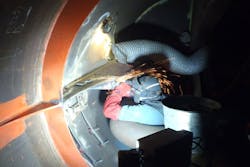New welding procedure helps vessels avoid drydocking
Offshore staff
STONEHAVEN, UK– Whittaker Engineering has developed a water-backed welding procedure for vessels that can prevent docking and resultant loss of production.
This procedure was successfully deployed byEnQuest on the Northern Producer floating production unit during routine work.
Traditional welding specifications used for the design and manufacture of FPUs and oil rigs do not take into account the cooling effects of seawater, Whittaker Engineering said. Its procedure uses high-powered induction heating coils to maintain a pre-heat temperature while welding water-backed plate, mitigating the heat loss through a ship’s hull into the cold temperature of the sea.
Greig Ritchie, operations manager for theNorthern Producer, said: “This is a truly noteworthy welding development that has helped EnQuest carry out work in the most efficient way. The procedure enables in situ modifications and repairs and avoids unnecessary and inefficient dry dock periods. It has significant potential for operators of vessels both in the North Sea and elsewhere.”
The resultant weld with the induction heater is ductile, low in hardness and has proved as high in quality as if it was performed without water around it. The same technique can be applied to corrosion and pitting in the hull. Whittaker believes it is the only company in the world currently offering this procedure with full Lloyd’s Register classification.
Induction heating involves huge currents surging backwards and forwards through induction coils to generate high temperatures. Cooling water and electricity flows through the coils from the power supply on deck and routed to where the welding is carried out. The power supply for the inductors has a maximum range of 75 m (246 ft) from the power source on deck to the welding repair area.
The presence of seawater on the outside of a hull structure increases the rate of cooling of weld metal. Fast cooling rates can produce hard martensitic structures in basic carbon steels which in turn can lead to cracking. Furthermore, the cold seawater encourages condensation at the weld site, which further increases the risk of hydrogen cracking.
Conventional ceramic electric heating pads do not supply sufficient heat (typically a maximum of 30°C/86°F is reached) to combat the cooling effect of the seawater.
However, with a sufficiently powerful induction heater, Whittaker can achieve a constant preheat of 75°C to 100°C (167°F to 212°F) with seawater at 5°C (41°F), a typical North Sea temperature.
Ken Whittaker of Whittaker Engineering said: “Many oil and gas vessels are expected to be at sea for 15 years or more. By carrying out the work offshore, we can potentially save companies millions of pounds by avoiding dry docking and loss of production through downtime.
“This is our fourth deployment and each one has been successful. Independent testing has also proved that our water-backed weld with induction heating is at least as strong and reliable as those carried out in a shipyard in the dry.”
08/02/2016
